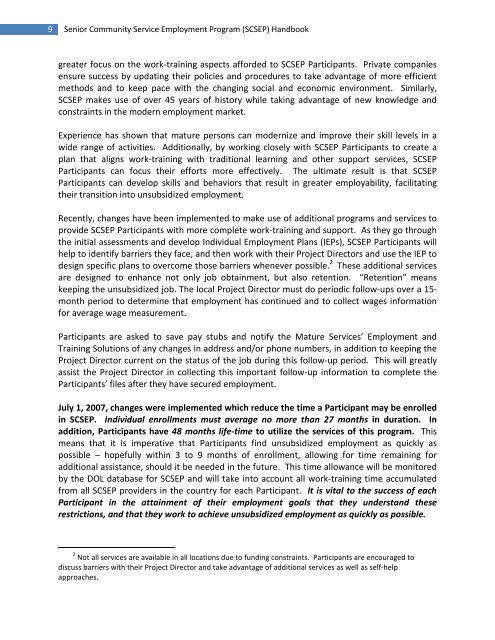Senior Community Service Employment Program ... - Mature Services
Senior Community Service Employment Program ... - Mature Services
Senior Community Service Employment Program ... - Mature Services
You also want an ePaper? Increase the reach of your titles
YUMPU automatically turns print PDFs into web optimized ePapers that Google loves.
9 <strong>Senior</strong> <strong>Community</strong> <strong>Service</strong> <strong>Employment</strong> <strong>Program</strong> (SCSEP) Handbookgreater focus on the work-training aspects afforded to SCSEP Participants. Private companiesensure success by updating their policies and procedures to take advantage of more efficientmethods and to keep pace with the changing social and economic environment. Similarly,SCSEP makes use of over 45 years of history while taking advantage of new knowledge andconstraints in the modern employment market.Experience has shown that mature persons can modernize and improve their skill levels in awide range of activities. Additionally, by working closely with SCSEP Participants to create aplan that aligns work-training with traditional learning and other support services, SCSEPParticipants can focus their efforts more effectively. The ultimate result is that SCSEPParticipants can develop skills and behaviors that result in greater employability, facilitatingtheir transition into unsubsidized employment.Recently, changes have been implemented to make use of additional programs and services toprovide SCSEP Participants with more complete work-training and support. As they go throughthe initial assessments and develop Individual <strong>Employment</strong> Plans (IEPs), SCSEP Participants willhelp to identify barriers they face, and then work with their Project Directors and use the IEP todesign specific plans to overcome those barriers whenever possible. 2 These additional servicesare designed to enhance not only job obtainment, but also retention. “Retention” meanskeeping the unsubsidized job. The local Project Director must do periodic follow-ups over a 15-month period to determine that employment has continued and to collect wages informationfor average wage measurement.Participants are asked to save pay stubs and notify the <strong>Mature</strong> <strong>Service</strong>s’ <strong>Employment</strong> andTraining Solutions of any changes in address and/or phone numbers, in addition to keeping theProject Director current on the status of the job during this follow-up period. This will greatlyassist the Project Director in collecting this important follow-up information to complete theParticipants’ files after they have secured employment.July 1, 2007, changes were implemented which reduce the time a Participant may be enrolledin SCSEP. Individual enrollments must average no more than 27 months in duration. Inaddition, Participants have 48 months life-time to utilize the services of this program. Thismeans that it is imperative that Participants find unsubsidized employment as quickly aspossible – hopefully within 3 to 9 months of enrollment, allowing for time remaining foradditional assistance, should it be needed in the future. This time allowance will be monitoredby the DOL database for SCSEP and will take into account all work-training time accumulatedfrom all SCSEP providers in the country for each Participant. It is vital to the success of eachParticipant in the attainment of their employment goals that they understand theserestrictions, and that they work to achieve unsubsidized employment as quickly as possible.2 Not all services are available in all locations due to funding constraints. Participants are encouraged todiscuss barriers with their Project Director and take advantage of additional services as well as self-helpapproaches.


